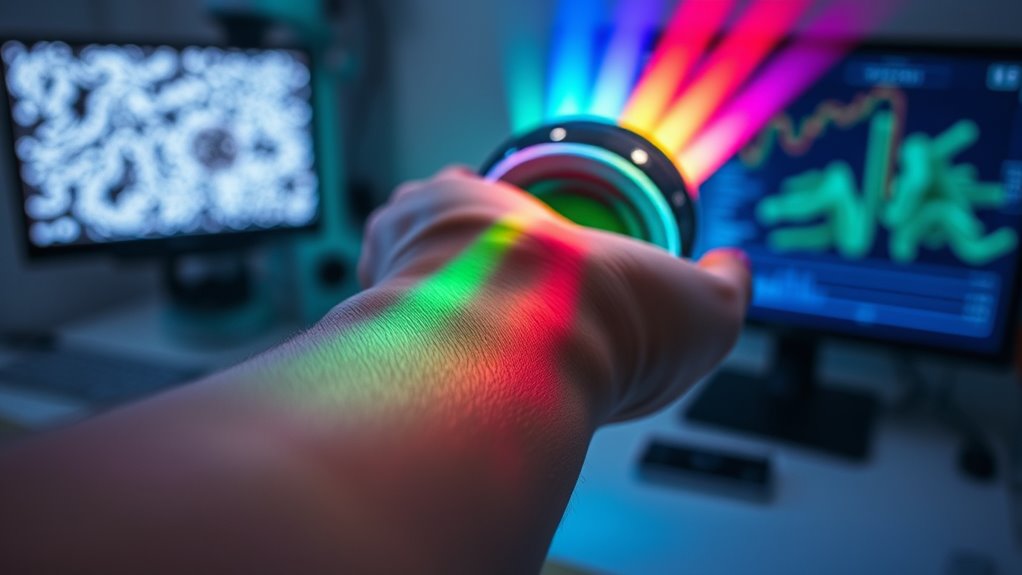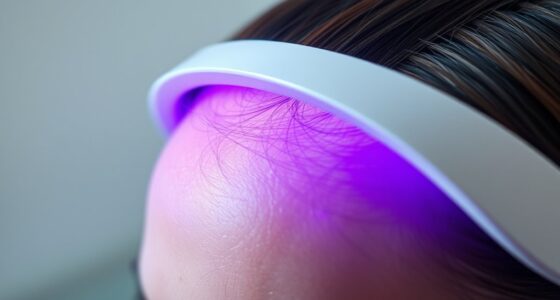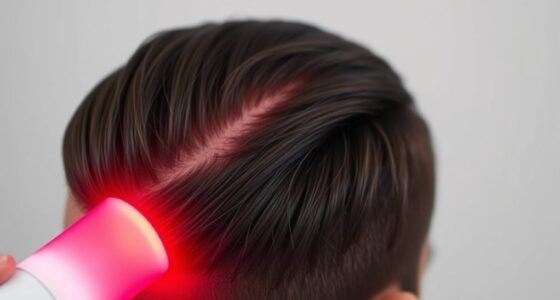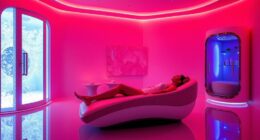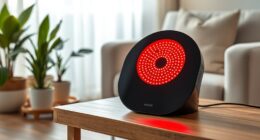Emerging research suggests that light therapy can influence your gut microbiome by regulating circadian rhythms and hormones like serotonin, which affect gut health. Proper light exposure during the day helps maintain microbial diversity and balance, supporting overall digestive health. Disrupted light patterns, especially from screens at night, may harm this balance. Understanding how light impacts your microbiome could lead to simple strategies for improving both mood and gut wellness—stay tuned to discover more ways to optimize your health.
Key Takeaways
- Emerging research indicates light therapy can enhance microbial diversity and balance in the gut microbiome.
- Light exposure influences circadian rhythms, which regulate gut bacteria composition and overall digestive health.
- Modulating hormones like serotonin through light therapy may indirectly promote healthier gut microbiota.
- Managing daily light environments, including natural light and reduced blue light at night, supports microbiome stability.
- Future studies explore combining light therapy with dietary or probiotic strategies to optimize gut health.

Light therapy, commonly used to treat mood disorders and sleep issues, may also influence the microbiome—the diverse community of bacteria living in your gut. This connection is gaining attention because both your mental health and gut health are intricately linked, often affecting each other in ways you might not realize. Researchers are exploring how exposure to certain light wavelengths could alter your gut bacteria, potentially impacting everything from digestion to immune function. It’s a fascinating area because it suggests that simply adjusting your light environment might have broader health effects than previously thought.
Recent studies indicate that light influences your circadian rhythms, the internal clock that regulates sleep-wake cycles and various bodily functions. When your circadian rhythms are disrupted, your gut bacteria can become imbalanced, leading to digestive issues, inflammation, and even mood disturbances. By using light therapy to stabilize these rhythms, you might help promote a healthier microbiome. Bright light exposure in the morning, for instance, can reinforce your circadian timing, encouraging better sleep and, consequently, more balanced gut bacteria. Conversely, irregular light exposure—like staying indoors all day or using screens late at night—can throw off your internal clock, negatively affecting your microbiome.
Stable light exposure supports your circadian rhythm and promotes a healthier, balanced gut microbiome.
Emerging research suggests that the effects of light therapy extend beyond mood and sleep, potentially influencing the diversity and composition of your gut bacteria. Changes in microbial diversity are considered a marker of overall gut health; a more diverse microbiome is generally healthier and more resilient. Light exposure might promote this diversity by regulating hormones and immune responses that shape microbial communities. For example, light can influence levels of serotonin, a neurotransmitter involved in mood and gut motility, which in turn impacts bacterial populations. It’s possible that targeted light therapy could serve as a non-invasive way to support gut health by modulating these interconnected systems. Additionally, environmental interactions, including light exposure, are part of the broader developmental factors that influence the microbiome throughout life.
While scientists are still unraveling the precise mechanisms, the evidence points toward a promising link between light therapy and microbiome health. This growing understanding opens the door to new treatments that combine light exposure with dietary or probiotic interventions, aiming to optimize both mental well-being and gut health. As you consider your own health routines, it’s worth noting that managing your light environment—getting natural light during the day and minimizing blue light at night—might help support a balanced microbiome. Although more research is needed, the emerging connection between light therapy and your microbiome underscores how integrated your body’s systems truly are, and how small changes in your daily habits could have wide-reaching benefits.
Frequently Asked Questions
Can Light Therapy Directly Alter Gut Microbiota Diversity?
Yes, light therapy can directly alter your gut microbiota diversity. When you use specific wavelengths of light, it influences cellular processes in your body, including those in your gut. This can promote beneficial bacteria growth and reduce harmful strains. By adjusting light exposure, you might improve your gut health and overall microbiome balance. Regular light therapy sessions could become a non-invasive way to support your digestive health and microbiome diversity.
Are Specific Wavelengths More Effective for Microbiome Health?
Absolutely, certain wavelengths can be more powerful than a superhero’s strength when it comes to microbiome health. Blue and near-infrared light show promising results, as they penetrate tissues deeply and stimulate cellular functions beneficial for gut bacteria. You should focus on these wavelengths, as they’ve been shown to enhance microbial diversity and support gut health. Think of it as turbo-charging your microbiome for peak digestion and immunity!
How Long Does It Take to See Microbiome Changes From Light Therapy?
You might start noticing microbiome changes within a few weeks of consistent light therapy. Usually, it takes about 4 to 6 weeks for your body to respond and for significant shifts to occur in your gut bacteria. Keep in mind, individual results vary depending on factors like wavelength used, session frequency, and your overall health. Patience and regular treatment are key to seeing meaningful improvements.
Are There Risks of Disrupting Beneficial Microbes With Light Exposure?
While light exposure is generally gentle, there’s a small chance it could nudge your beneficial microbes out of balance. You might notice subtle shifts, but these are often temporary and manageable. To protect your microbiome, follow recommended guidelines and avoid overexposure. Staying mindful helps make sure your vibrant inner ecosystem remains resilient, allowing the healing and harmony you seek to flourish without unintended disruptions.
Does Individual Microbiome Composition Affect Light Therapy Outcomes?
Your microbiome composition can definitely influence how you respond to light therapy. If your beneficial microbes are disrupted or imbalanced, you might experience different or less effective outcomes. Personalized approaches considering your unique microbiome could optimize results. Keep in mind that ongoing research is exploring this connection, so staying informed and consulting with healthcare professionals can help tailor treatments to your specific microbial makeup.
Conclusion
As research reveals a remarkable relationship between light therapy and the microbiome, it’s clear that this connection could cultivate essential health changes. By harnessing healthy hues and understanding microbial mysteries, you can potentially boost your wellbeing and balance. Stay curious and conscious of these intriguing connections, because embracing innovative insights could open doors to better balance, brighter days, and a healthier you. Keep exploring, and let this emerging evidence enlighten your journey toward wellness!
